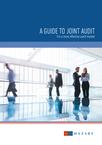
Joint Audit
There is widespread consensus that the audit sector is not reaching its potential, and that previous attempts at reform have been ineffective. The impact of high-quality audit goes far beyond the boardroom.
As the CMA (Competition and Markets Authority in the UK) Chairman Andrew Tyrie explains: “Most people will never read an auditor’s opinion on a company’s accounts. But tens of millions of people depend on robust and high-quality audits. If a company’s books aren’t properly examined, people’s jobs, pensions or savings can be at risk”.
Trust in the quality of audit underpins confidence in business, the money invested in listed firms by private and institutional investors, and the livelihoods of the people who work for and with the audited companies. There is now unanimous agreement that the overwhelming dominance of just four firms in the global audit market is unsustainable and that reform is required to go from “four to more”. The desired objectives of audit reform are reducing market concentration, increasing competition and improving audit quality.
Joint audit can also be considered as a means to address the challenge of transformation.
If we are to create a vibrant, innovative audit market meeting the needs of shareholders, company stakeholders and wider society into the middle of the 21st Century, we must kick-start the creation of a competitive market in a manner that will ensure new entrants become auditors of listed entities.
If undertaken in the right spirit of collaboration, we believe joint audit also reinforces governance arrangements on the conduct of audits and delivers real improvements in audit quality.
This document brings together our thoughts and experience of joint audit, find out more by downloading it here:
Joint Audit: The Facts

Joint Audit in South Africa

Want to know more?



